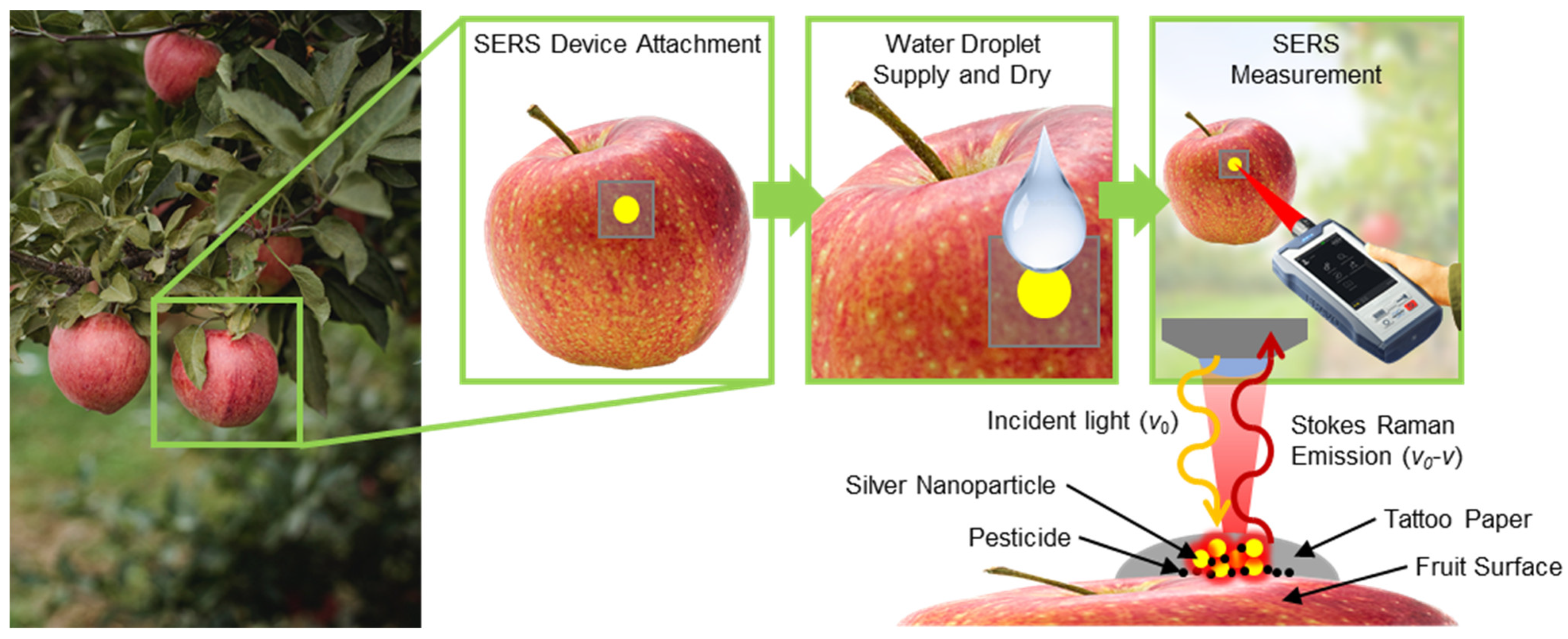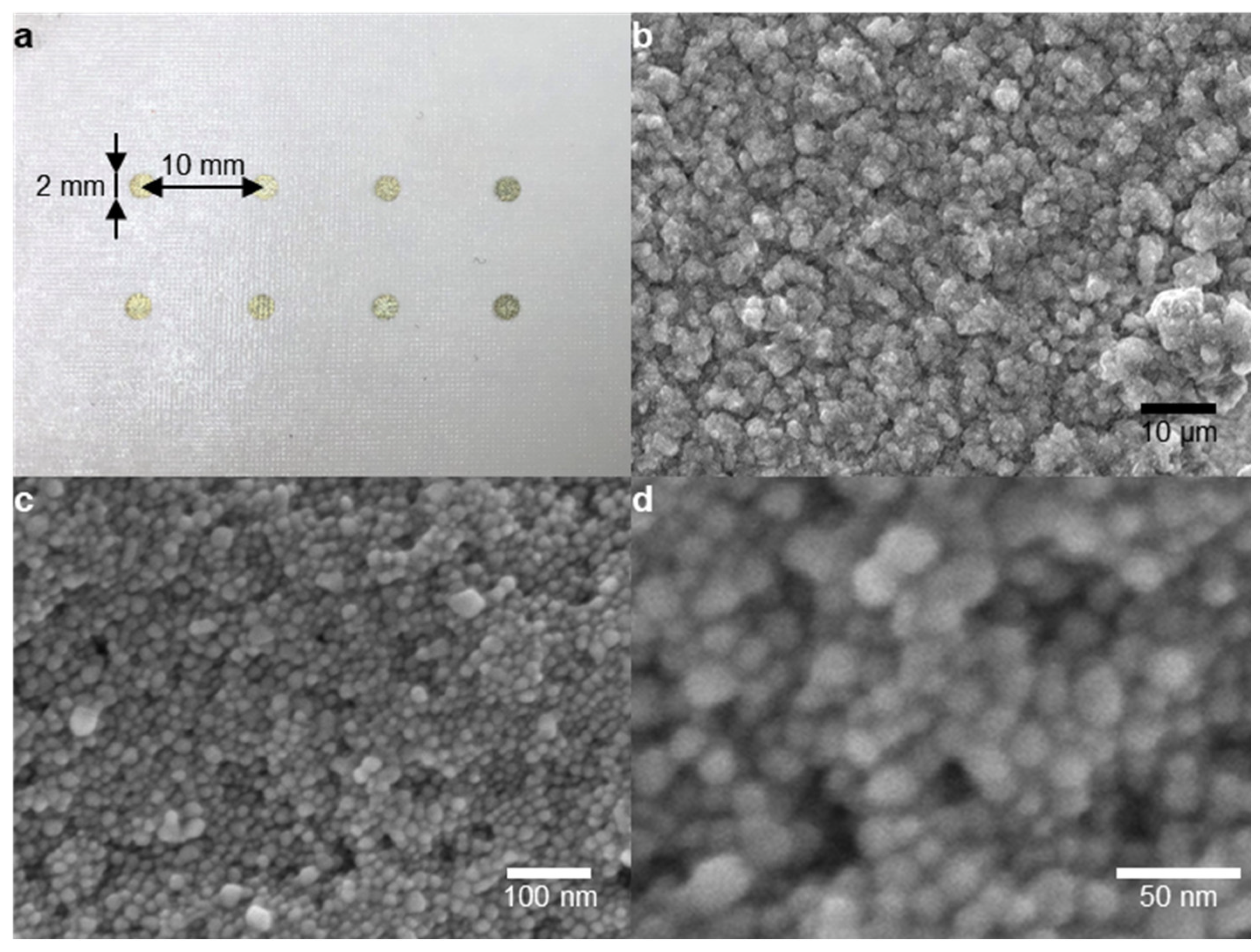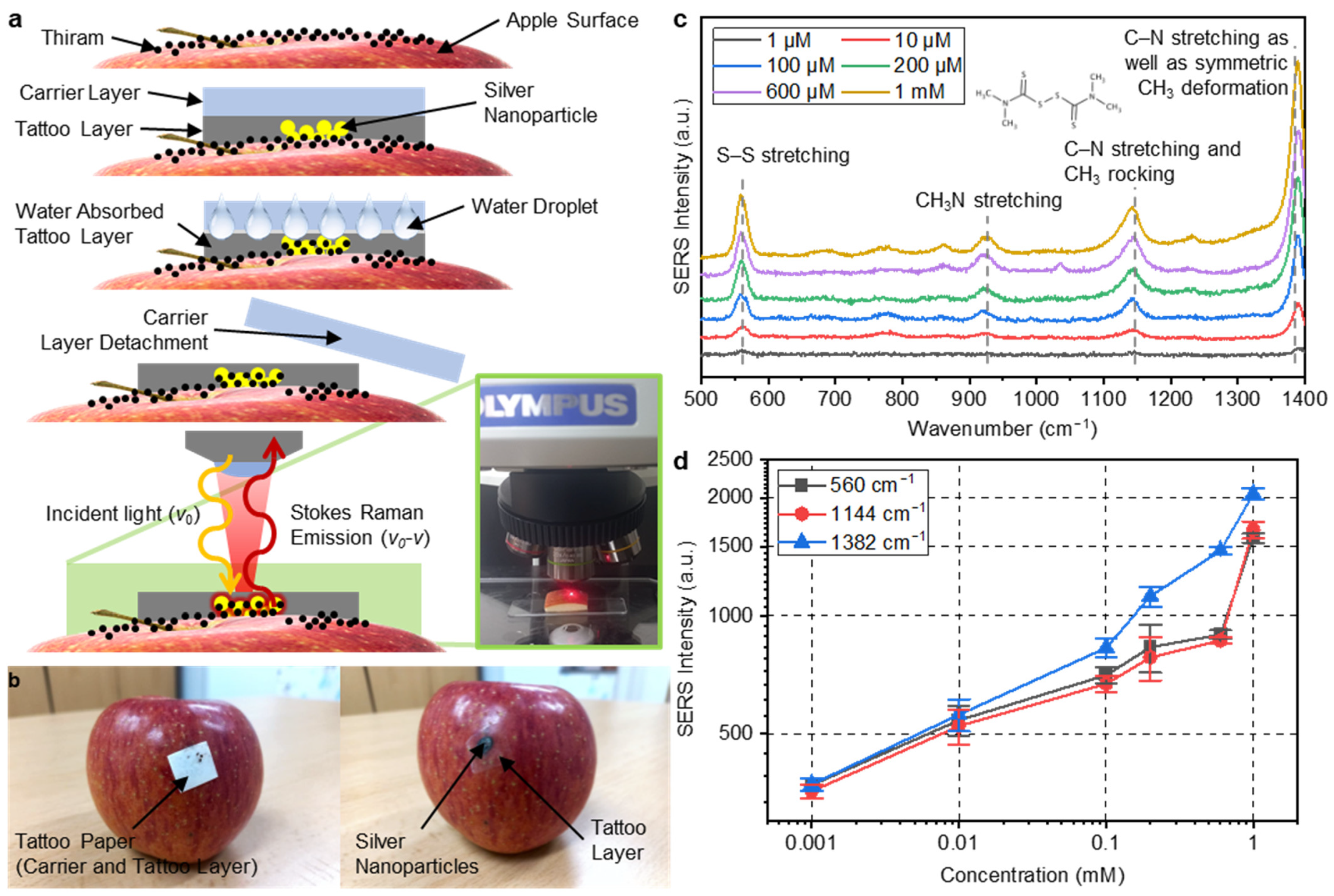Cost-Effective and Facile Fabrication of a Tattoo Paper-Based SERS Substrate and Its Application in Pesticide Sensing on Fruit Surfaces
Abstract
1. Introduction
2. Materials and Methods
2.1. Chemicals and Reagents
2.2. Fabrication of Tattoo Paper-Based AgNP SERS Substrates
2.3. Analysis of Tattoo Paper-Based AgNP SERS Substrates
2.4. SERS Spectrum Measurement of Thiram
2.5. SERS Spectrum Measurement of Thiram Using Real Fruit
3. Results and Discussion
3.1. Characteristics of Tattoo Paper-Based AgNP SERS Substrates
3.2. Identification of Benzenethiol and Thiram
3.3. Identification of Thiram Using Real Fruit
4. Conclusions
Author Contributions
Funding
Institutional Review Board Statement
Informed Consent Statement
Data Availability Statement
Conflicts of Interest
References
- Sivaperumal, P.; Thasale, R.; Kumar, D.; Mehta, T.G.; Limbachiya, R. Human health risk assessment of pesticide residues in vegetable and fruit samples in Gujarat State, India. Heliyon 2022, 8, e10876. [Google Scholar]
- Lerro, C.C.; Beane Freeman, L.E.; DellaValle, C.T.; Andreotti, G.; Hofmann, J.N.; Koutros, S.; Parks, C.G.; Shrestha, S.; Alavanja, M.C.R.; Blair, A.; et al. Pesticide exposure and incident thyroid cancer among male pesticide applicators in agricultural health study. Environ. Int. 2021, 146, 106187. [Google Scholar] [CrossRef]
- Islam, M.A.; Amin, S.M.N.; Rahman, M.A.; Juraimi, A.S.; Uddin, M.K.; Brown, C.L.; Arshad, A. Chronic effects of organic pesticides on the aquatic environment and human health: A review. Environ. Nanotechnol. Monit. Manag. 2022, 18, 100740. [Google Scholar] [CrossRef]
- Alder, L.; Greulich, K.; Kempe, G.; Vieth, B. Residue analysis of 500 high priority pesticides: Better by GC-MS or LC-MS/MS? Mass. Spectrom. Rev. 2006, 25, 838–865. [Google Scholar] [CrossRef]
- Khetagoudar, M.C.; Chetti, M.B.; Bilehal, D.C. Gas Chromatographic-Mass Spectrometric Detection of Pesticide Residues in Grapes. In Gas Chromatography; Kusch, P., Ed.; IntechOpen: Rijeka, Croatia, 2019; Chapter 5; pp. 1–11. [Google Scholar]
- Hogendoorn, E.A. High-Performance Liquid Chromatography Methods in Pesticide Residue Analysis. In Encyclopedia of Analytical Chemistry, 1st ed.; John Wiley & Sons, LTD.: Hoboken, NJ, USA, 2006; pp. 1–36. [Google Scholar]
- Albero, B.; Sánchez-Brunete, C.; Tadeo, J.L. Determination of Thiabendazole in Orange Juice and Rind by Liquid Chromatography with Fluorescence Detection and Confirmation by Gas Chromatography/Mass Spectrometry After Extraction by Matrix Solid-Phase Dispersion. J. AOAC Int. 2019, 87, 664–670. [Google Scholar] [CrossRef]
- Ping, H.; Wang, B.; Li, C.; Li, Y.; Ha, X.; Jia, W.; Li, B.; Ma, Z. Potential health risk of pesticide residues in greenhouse vegetables under modern urban agriculture: A case study in Beijing, China. J. Food Compos. Anal. 2022, 105, 104222. [Google Scholar] [CrossRef]
- Nunes, G.S.; Toscano, I.A.; Barceló, D. Analysis of pesticides in food and environmental samples by enzyme-linked immunosorbent assays. TrAC Trends Anal. Chem. 1998, 17, 79–87. [Google Scholar] [CrossRef]
- Wu, S.; Yan, C.; Fan, X.; Wang, H.; Wang, Y.; Peng, D. Development of enzyme-linked immunosorbent assay and colloidal gold-based immunochromatographic assay for the rapid detection of gentamicin in chicken muscle and milk. Chin. J. Anal. Chem. 2022, 50, 100142. [Google Scholar] [CrossRef]
- Huang, R.; Huang, Y.; Liu, H.; Guan, K.; Chen, A.; Zhao, X.; Wang, S.; Zhang, L. A bifunctional AuNP probe-based enzyme-linked immunosorbent assay for facile and ultrasensitive detection of trace zearalenone in coix seed. Microchem. J. 2023, 184, 108152. [Google Scholar] [CrossRef]
- Feng, R.; Wang, M.; Qian, J.; He, Q.; Zhang, M.; Zhang, J.; Zhao, H.; Wang, B. Monoclonal antibody-based enzyme-linked immunosorbent assay and lateral flow immunoassay for the rapid screening of paraquat in adulterated herbicides. Microchem. J. 2022, 180, 107644. [Google Scholar] [CrossRef]
- Pang, S.; Labuza, T.P.; He, L. Development of a single aptamer-based surface enhanced Raman scattering method for rapid detection of multiple pesticides. Analyst 2014, 139, 1895–1901. [Google Scholar] [CrossRef]
- Khadem, M.; Faridbod, F.; Norouzi, P.; Foroushani, A.R.; Ganjali, M.R.; Shahtaheri, S.J. Biomimetic electrochemical sensor based on molecularly imprinted polymer for dicloran pesticide determination in biological and environmental samples. J. Iran. Chem. Soc. 2016, 13, 2077–2084. [Google Scholar] [CrossRef]
- Moriwaki, H.; Yamada, K.; Nakanishi, H. Evaluation of the Interaction between Pesticides and a Cell Membrane Model by Surface Plasmon Resonance Spectroscopy Analysis. J. Agric. Food Chem. 2017, 65, 5390–5396. [Google Scholar] [CrossRef]
- Kumar, S.; Goel, P.; Singh, J.P. Flexible and robust SERS active substrates for conformal rapid detection of pesticide residues from fruits. Sens. Actuators B Chem. 2017, 241, 577–583. [Google Scholar] [CrossRef]
- Kahraman, M.; Mullen, E.R.; Korkmaz, A.; Wachsmann-Hogiu, S. Fundamentals and applications of SERS-based bioanalytical sensing. Nanophotonics 2017, 6, 831–852. [Google Scholar] [CrossRef]
- Pilot, R.; Signorini, R.; Durante, C.; Orian, L.; Bhamidipati, M.; Fabris, L. A Review on Surface-Enhanced Raman Scattering. Biosensors 2019, 9, 57. [Google Scholar] [CrossRef]
- Langer, J.; Jimenez de Aberasturi, D.; Aizpurua, J.; Alvarez-Puebla, R.; Auguié, B.; Baumberg, J.J.; Bazan, G.C.; Bell, S.E.J.; Boisen, A.; Brolo, A.G.; et al. Present and Future of Surface-Enhanced Raman Scattering. ACS Nano 2020, 14, 28–117. [Google Scholar] [CrossRef]
- He, S.; Xie, W.; Fang, S.; Huang, X.; Zhou, D.; Zhang, Z.; Du, J.; Du, C.; Wang, D. Silver films coated inverted cone-shaped nanopore array anodic aluminum oxide membranes for SERS analysis of trace molecular orientation. Appl. Surf. Sci. 2019, 488, 707–713. [Google Scholar] [CrossRef]
- Liu, Y.; Wu, S.; Du, X.; Sun, J. Plasmonic Ag nanocube enhanced SERS biosensor for sensitive detection of oral cancer DNA based on nicking endonuclease signal amplification and heated electrode. Sens. Actuators B Chem. 2021, 338, 129854. [Google Scholar] [CrossRef]
- Mandavkar, R.; Lin, S.; Pandit, S.; Kulkarni, R.; Burse, S.; Habib, M.A.; Kunwar, S.; Lee, J. Hybrid SERS platform by adapting both chemical mechanism and electromagnetic mechanism enhancements: SERS of 4-ATP and CV by the mixture with GQDs on hybrid PdAg NPs. Surf. Interfaces 2022, 33, 102175. [Google Scholar] [CrossRef]
- Moronshing, M.; Bhaskar, S.; Mondal, S.; Ramamurthy, S.S.; Subramaniam, C. Surface-enhanced Raman scattering platform operating over wide pH range with minimal chemical enhancement effects: Test case of tyrosine. J. Raman Spectrosc. 2019, 50, 826–836. [Google Scholar] [CrossRef]
- Bhaskar, S.; Thacharakkal, D.; Ramamurthy, S.S.; Subramaniam, C. Metal–Dielectric Interfacial Engineering with Mesoporous Nano-Carbon Florets for 1000-Fold Fluorescence Enhancements: Smartphone-Enabled Visual Detection of Perindopril Erbumine at a Single-molecular Level. ACS Sustain. Chem. Eng. 2023, 11, 78–91. [Google Scholar] [CrossRef]
- Parmigiani, M.; Albini, B.; Pellegrini, G.; Genovesi, M.; De Vita, L.; Pallavicini, P.; Dacarro, G.; Galinetto, P.; Taglietti, A. Surface-Enhanced Raman Spectroscopy Chips Based on Silver Coated Gold Nanostars. Nanomaterials 2022, 12, 3609. [Google Scholar] [CrossRef]
- Gao, T.; Xu, Z.; Fang, F.; Gao, W.; Zhang, Q.; Xu, X. High performance surface-enhanced Raman scattering substrates of Si-based Au film developed by focused ion beam nanofabrication. Nanoscale Res. Lett. 2012, 7, 399. [Google Scholar] [CrossRef]
- Melekhov, E.; Penn, T.; Weidauer, T.; Abb, V.; Kammler, M.; Lechner, A. Tunable nanopillar array on a quartz-fiber tip for surface enhanced Raman scattering (SERS) detection. Tech. Mess. 2022, 89, 70–81. [Google Scholar] [CrossRef]
- Chen, X.; Lin, M.; Sun, L.; Xu, T.; Lai, K.; Huang, M.; Lin, H. Detection and quantification of carbendazim in Oolong tea by surface-enhanced Raman spectroscopy and gold nanoparticle substrates. Food Chem. 2019, 293, 271–277. [Google Scholar] [CrossRef]
- Sitjar, J.; Liao, J.; Lee, H.; Liu, B.H.; Fu, W. SERS-Active Substrate with Collective Amplification Design for Trace Analysis of Pesticides. Nanomaterials 2019, 9, 664. [Google Scholar] [CrossRef]
- Calis, B.; Yilmaz, M. Fabrication of gold nanostructure decorated polystyrene hybrid nanosystems via poly(L-DOPA) and their applications in surface-enhanced Raman Spectroscopy (SERS), and catalytic activity. Colloids Surf. A Physicochem. Eng. Asp. 2021, 622, 126654. [Google Scholar] [CrossRef]
- Yang, D.; Cho, H.; Koo, S.; Vaidyanathan, S.R.; Woo, K.; Yoon, Y.; Choo, H. Simple, Large-Scale Fabrication of Uniform Raman-Enhancing Substrate with Enhancement Saturation. ACS Appl. Mater. Interfaces 2017, 9, 19092–19101. [Google Scholar] [CrossRef]
- Izquierdo-Lorenzo, I.; Jradi, S.; Adam, P. Direct laser writing of random Au nanoparticle three-dimensional structures for highly reproducible micro-SERS measurements. RSC Adv. 2014, 4, 4128–4133. [Google Scholar] [CrossRef]
- Liu, S.; Tian, X.; Guo, J.; Kong, X.; Xu, L.; Yu, Q.; Wang, A.X. Multi-functional plasmonic fabrics: A flexible SERS substrate and anti-counterfeiting security labels with tunable encoding information. Appl. Surf. Sci. 2021, 567, 150861. [Google Scholar] [CrossRef]
- Chen, Y.; Ge, F.; Guang, S.; Cai, Z. Low-cost and large-scale flexible SERS-cotton fabric as a wipe substrate for surface trace analysis. Appl. Surf. Sci. 2018, 436, 111–116. [Google Scholar] [CrossRef]
- Lin, S.; Lin, X.; Han, S.; Liu, Y.; Hasi, W.; Wang, L. Flexible fabrication of a paper-fluidic SERS sensor coated with a monolayer of core–shell nanospheres for reliable quantitative SERS measurements. Anal. Chim. Acta 2020, 1108, 167–176. [Google Scholar] [CrossRef]
- Luo, J.; Wang, Z.; Li, Y.; Wang, C.; Sun, J.; Ye, W.; Wang, X.; Shao, B. Durable and flexible Ag-nanowire-embedded PDMS films for the recyclable swabbing detection of malachite green residue in fruits and fingerprints. Sens. Actuators B Chem. 2021, 347, 130602. [Google Scholar] [CrossRef]
- Zhang, S.; Xu, J.; Liu, Z.; Huang, Y.; Fu, R.; Jiang, S. Facile and scalable preparation of solution-processed succulent-like silver nanoflowers for 3D flexible nanocellulose-based SERS sensors. Surf. Interfaces 2022, 34, 102391. [Google Scholar] [CrossRef]
- Cai, Y.; Yao, X.; Piao, X.; Zhang, Z.; Nie, E.; Sun, Z. Inkjet printing of particle-free silver conductive ink with low sintering temperature on flexible substrates. Chem. Phys. Lett. 2019, 737, 136857. [Google Scholar] [CrossRef]
- Botti, S.; Rufoloni, A.; Rindzevicius, T.; Schmidt, M.S. Surface-Enhanced Raman Spectroscopy Characterization of Pristine and Functionalized Carbon Nanotubes and Graphene. In Raman Spectroscopy; Morari do Nascimento, G., Ed.; IntechOpen: Rijeka, Croatia, 2018; Chapter 10; pp. 203–219. [Google Scholar]
- Pu, H.; Huang, Z.; Xu, F.; Sun, D. Two-dimensional self-assembled Au-Ag core-shell nanorods nanoarray for sensitive detection of thiram in apple using surface-enhanced Raman spectroscopy. Food Chem. 2021, 343, 128548. [Google Scholar] [CrossRef]
- Zheng, X.; Chen, Y.; Chen, Y.; Bi, N.; Qi, H.; Qin, M.; Song, D.; Zhang, H.; Tian, Y. High performance Au/Ag core/shell bipyramids for determination of thiram based on surface-enhanced Raman scattering. J. Raman Spectrosc. 2012, 43, 1374–1380. [Google Scholar] [CrossRef]
- Varadachari, C.; Mitra, S.; Ghosh, K. Photochemical oxidation of soil organic matter by sunlight. Proc. Indian Natl. Sci. Acad. 2017, 83, 223–229. [Google Scholar]
- Böhnke, P.R.; Kruppke, I.; Hoffmann, D.; Richter, M.; Häntzsche, E.; Gereke, T.; Kruppke, B.; Cherif, C. Matrix Decomposition of Carbon-Fiber-Reinforced Plastics via the Activation of Semiconductors. Materials 2020, 13, 3267. [Google Scholar] [CrossRef]
- Austin, A.T.; Méndez, M.S.; Ballaré, C.L. Photodegradation alleviates the lignin bottleneck for carbon turnover in terrestrial ecosystems. Proc. Natl. Acad. Sci. USA 2016, 113, 4392–4397. [Google Scholar] [CrossRef]
- Ravikumar, S.; Mani, D.; Rizwan Khan, M.; Ahmad, N.; Gajalakshmi, P.; Surya, C.; Durairaj, S.; Pandiyan, V.; Ahn, Y. Effect of silver incorporation on the photocatalytic degradation of Reactive Red 120 using ZnS nanoparticles under UV and solar light irradiation. Environ. Res. 2022, 209, 112819. [Google Scholar] [CrossRef]
- Gola, D.; Kriti, A.; Bhatt, N.; Bajpai, M.; Singh, A.; Arya, A.; Chauhan, N.; Srivastava, S.K.; Tyagi, P.K.; Agrawal, Y. Silver nanoparticles for enhanced dye degradation. Curr. Res. Green Sustain. Chem. 2021, 4, 100132. [Google Scholar] [CrossRef]
- Joo, T.H.; Kim, M.S.; Kim, K. Surface-enhanced Raman scattering of benzenethiol in silver sol. J. Raman. Spectrosc. 1987, 18, 57–60. [Google Scholar] [CrossRef]
- Chen, J.; Huang, Y.; Kannan, P.; Zhang, L.; Lin, Z.; Zhang, J.; Chen, T.; Guo, L. Flexible and Adhesive Surface Enhance Raman Scattering Active Tape for Rapid Detection of Pesticide Residues in Fruits and Vegetables. Anal. Chem. 2016, 88, 2149–2155. [Google Scholar] [CrossRef]
- European Food Safety Authority. Peer review of the pesticide risk assessment of the active substance thiram. EFSA J. 2017, 15, e04700. [Google Scholar]






Disclaimer/Publisher’s Note: The statements, opinions and data contained in all publications are solely those of the individual author(s) and contributor(s) and not of MDPI and/or the editor(s). MDPI and/or the editor(s) disclaim responsibility for any injury to people or property resulting from any ideas, methods, instructions or products referred to in the content. |
© 2023 by the authors. Licensee MDPI, Basel, Switzerland. This article is an open access article distributed under the terms and conditions of the Creative Commons Attribution (CC BY) license (https://creativecommons.org/licenses/by/4.0/).
Share and Cite
Mandrekar, P.P.; Kang, M.; Park, I.; Kim, B.; Yang, D. Cost-Effective and Facile Fabrication of a Tattoo Paper-Based SERS Substrate and Its Application in Pesticide Sensing on Fruit Surfaces. Nanomaterials 2023, 13, 486. https://doi.org/10.3390/nano13030486
Mandrekar PP, Kang M, Park I, Kim B, Yang D. Cost-Effective and Facile Fabrication of a Tattoo Paper-Based SERS Substrate and Its Application in Pesticide Sensing on Fruit Surfaces. Nanomaterials. 2023; 13(3):486. https://doi.org/10.3390/nano13030486
Chicago/Turabian StyleMandrekar, Pratiksha P., Mingu Kang, Inkyu Park, Bumjoo Kim, and Daejong Yang. 2023. "Cost-Effective and Facile Fabrication of a Tattoo Paper-Based SERS Substrate and Its Application in Pesticide Sensing on Fruit Surfaces" Nanomaterials 13, no. 3: 486. https://doi.org/10.3390/nano13030486
APA StyleMandrekar, P. P., Kang, M., Park, I., Kim, B., & Yang, D. (2023). Cost-Effective and Facile Fabrication of a Tattoo Paper-Based SERS Substrate and Its Application in Pesticide Sensing on Fruit Surfaces. Nanomaterials, 13(3), 486. https://doi.org/10.3390/nano13030486






